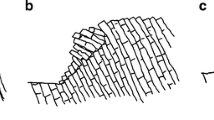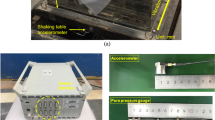Abstract
The development of geological processes on the slopes is a consequence of changes in the stress state of rock masses. This work presents a study of stress redistribution. As an example, a high (up to 2 km) slope of the Greater Caucasus Range has been taken. To solve the problem a numerical simulation was used. One of the main factors that cause changes in the stressed state of rocks, composing the slope, is seismicity. Redistribution of stresses under the action of seismic forces was studied in static and dynamic settings. For a heterogeneous slope the static problem was solved using variation-difference method and the field of seismic forces was replaced by an equivalent field of static ones. The dynamic problem was solved using a finite element method while studying stress changes in the slope rocks as a result of propagation of seismic waves. There were obtained regularities in the formation of concentration zones of stress intensity and their movements, which is a result of interaction between propagating and reflected (from the slope surface) seismic waves, depending on the steepness of slopes and direction of wave propagation. Comparing the obtained values of stresses and strength characteristics of rocks, an assessment of the slope stability was carried out.
Access provided by Autonomous University of Puebla. Download conference paper PDF
Similar content being viewed by others
Keywords
1 Factors of the Development of Landslide Processes and Varieties of the Assessment of Seismic Influence
Widespread gravitational slope processes are a direct consequence of changes in the stress state of rock masse, which is a result of external forces, characteristics of internal rock structure and landforms. Therefore, research and objective forecast of the origin and development of slope processes require an analysis of the distribution and stress changes in the rock massif, and should assess the influence of earthquakes on the redistribution of stresses (Kalinin et al. 1998).
Megaanticlinorium of the Greater Caucasus Range belongs to the regions where landslides and landfalls are widely spread. Beside severe topography, the main factors in the formation of landslides here are Jurassic shales with a relatively low strength, terrigenous flysch of Cretaceous-Paleogene and overlying deluvial-proluvial deposits, bedding of rocks, watering of the slopes by ground and surface waters as well as economic and building activity.
An important natural factor contributing to the formation of landslides, is high seismic activity of the region, where more than eight magnitude earthquakes can happen.
The object of the present study was the distribution of stresses in the high northern slope of Aibga ridge, which is a southern side of the Mzimta river valley in the area of active anthropogenic development. The geological structure of the slope involves Lower Jurassic terrigenous argillaceous rock strata, overlying in the upper part of the slope by a series of porphyritic massif formations of Middle Jurassic, and complicated by a series of sub-regional faulting.
To assess the stability of high slopes of the Aibga ridge, a stressed state of slope rock masses was mathematically simulated. Their heterogeneity on deformation properties and effects of seismic waves were taken into account. The effect of this is diverse and reveals itself in the redistribution of the rocks background of stress, which causes additional stresses changing in time and zones of their concentration in the slope massif. Moreover it also causes enlargement of the existing and formation of new cracks. It weakens the strength of the massif after repeated earthquakes.
The solution of the problem under the action of seismic forces was carried out in static and dynamic settings. When solving the static problem, the field of seismic forces is replaced by an equivalent field of static ones. For this a certain moment is considered, when the action of dynamic forces is the least favorable in direction and in their influence on the occurrence of stress concentration zones in the slope rocks. When solving the dynamic problem, the change in the stress state is established at all stages when seismic waves pass the rock massif: when the waves approach to the slope surface, when they reflect from the border of two media, when reflected waves interact with oncoming ones, etc.
The study of the effect of propagating seismic waves on the stress state of slope rock massif is very difficult, because the change of stresses and their distribution depend on the one hand, on the direction of propagation and parameters of seismic waves, and, on the other hand, on the structure, properties and geometry of a slope rock massif.
To study the stress state of natural rock massif, an analytical and a numerical mathematical modeling are used (Kalinin and Goldstein 1969; Samarsky 1982). For studying the distribution of stresses, the most universal numerical methods are variation-difference ones, based on a discrete mathematical model of the object (Savchenko 1984). This allows solve complex problems of mathematical physics effectively and which can be in particular used for the study of heterogeneous rock massifs (Kalinin et al. 2003).
2 Influence of Seismic Activity on Stresses and Their Redistribution in the Slope Rocks
2.1 Static Setting
At the first stage, with the help of numerical modeling a stress-strain state (SSS) of heterogeneous isotropic massifs within the studied slopes under gravity was studied, and the redistribution of stresses under the action of seismic forces in a static setting was explored. Seismic force was suggested to be horizontal pointed toward the least favorable direction—in the direction of the slope and with the acceleration according to the map GSZ-97 equal to 0.25 g. At the second stage, the calculation of stress distribution in time during the propagation of seismic compression-tension waves and their interaction with the surface irregularities was conducted. At the final stage, by comparing stresses and strength characteristics of rocks forming the slope, the degree of its stability was assessed. The modeling was carried out according to the programs worked out by the Department of engineering and environmental geology, Faculty of Geology, jointly with the Department of theory of composites of the Faculty of Mechanics and Mathematics of Moscow State University.
For the estimation of the stressed state of a rock massif, a profile was taken, which crosses almost the entire Northern slope of the Aibga ridge from a watershed to channel part of the Mzymta valley. The upper part of the slope is composed of porphyritic series of Middle Jurassic and lies monoclinally at the angle of 32–42°. The middle and bottom parts of the slope are composed of Lower Jurassic mudstones which lie at the angle of 16–31°. Porphyritic deposits border mudstones along South-Estosadoksky fault and are crossed by Krasnopolyansky fault falling on the north. In the middle of the slope the profile crosses a fault-landslide massif. In the lower part of the profile Lower Jurassic sediments are overlapped by alluvial-proluvial deposits of the Mzymty valley.
Calculations for the profile I–I show that normal stresses which exist on horizontal and vertical sites, increase with depth and decrease towards the valley. However, when approaching the bottom of the slope there is some horizontal stress growth. The shear stresses on the vertical and horizontal sites increase slightly near the surface of the slope in its middle and bottom parts. Taking into account seismic effects, vertical stresses increase slightly but horizontal stresses increase by 2–3 times, especially intensively in the lower part of the slope. Here shear stresses increase almost twice.
2.2 Dynamic Setting
For the northern slope of the Aigba ridge there was calculated stress redistribution in the seismic compression-tension wave in the dynamic setting (Kalinin et al. 1998). The slope is about 1.5 km. High with steepness of 25–30° and is composed of Lower Jurassic mudstones overlain by porphyritic sediments. Seismic impact was simulated with the velocity of propagation of longitudinal waves Vp = 1464 m/s, wave length equal to L = 732 m, the oscillation frequency f = 2 Hz and amplitude of the displacement of A0 = 0.1 cm. It was assumed that the seismic wave is flat, approaches the slope at the angle of 40°, and the rock massif forming the slope is elastic, homogeneous and isotropic, because the wavelength is much larger than the size of heterogeneous elements. At first, the wave meets the surface limiting the area from above, and the upper part of the slope, where considerable concentration of the stress intensity occurs as a result of interference of coming and reflected waves. As the wave moves forward, the stress concentration zone moves down the slope, while below the upper border of power the stress concentration zone (which occurred earlier) increases in power. That is well correlated with the zone of higher stresses obtained in the static setting. Further the stress concentration zone expands and reaches the bottom of the slope (Fig. 219.1). Maximum values of stress intensity are 1.5–2 MPa.
3 The Assessment of the Slope Stability
The assessment of the coefficient of slope stability was carried out by comparing calculated stresses with strength characteristics of rocks that form the slope, based on the theory of strength by Mohr-Coulomb (Tsytovich and Ter-Martirosyan 1981). The analysis of the received results revealed zones with critical ratio of stresses and strength that can cause shear deformation in the massif as well as surface sliding. While evaluating the stability of the northern slope of Aibga ridge, a strength coefficient and stability factor were obtained.
The calculations of the stress-strain state and stability of the northern slope of Aibga ridge showed that without seismic activity, the lowest part of the slope belongs to unstable zones (when stability coefficient is less than 1). Its section is composed of Jurassic mudstones (Fig. 219.2a). If a 9 magnitude seismicity is simulated in the lower part of the slope, then the area of unstable mudstone massif increases several times. And also there appears an unstable zone on the site of a landslide (Fig. 219.2b).
Thus, the study of a stress state of heterogeneous rock massif and the evaluation of slope stability by means of numerical simulations have revealed some potentially unstable areas. It also helped in assessing the level of influence of 9 magnitude seismic activity on the slope stability. All these must be considered while designing and building new engineering structures.
References
Kalinin EV, Goldstein RV (1969) Experience in the use of analytical method for the evaluation of the stress state of a rock massif in the sides and bottom of deep river valleys. Moscow University Geology Bulletin 24(5)
Kalinin EV, Panasyan LL, Artamonova NB (2003) Modeling of stress fields in geotechnical massifs. Moscow University Press, Moscow
Kalinin EV, Panasiyan LL, Zerkal OV (1998) The seismic wave effect on the slope stability. In: Sivakumar M, Chowdhury RN (eds) Second international conference on environmental engineering (ICEM2). ELSEVIER, pp 1065–1071
Kalinin EV, Sheshenin SV, Buyakov MI (1994) Changes in the stress - strain state of the rocks, composing the slope valleys, under seismicity. Mosc Univ Geol Bull 49(6):43–48
Samarsky AA (1982) Introduction to numerical methods. Nauka, Moscow
Savchenko SN (1984) Analytical approaches to the evaluation of the stress state of rock massifs in the systems of mountainous terrain. In: The stress state of rocks and rock pressure in the structures of the mountainous terrain. Nauka, Leningrad, pp 57–105
Tsytovich NA, Ter-Martirosyan ZG (1981) Fundamentals of applied geomechanics in construction. High School, Moscow
Author information
Authors and Affiliations
Corresponding author
Editor information
Editors and Affiliations
Rights and permissions
Copyright information
© 2015 Springer International Publishing Switzerland
About this paper
Cite this paper
Zerkal, O.V., Kalinin, E.V., Panasyan, L.L. (2015). The Formation and Distribution of Stress Concentration Zones in Heterogeneous Rock Masses with Slopes. In: Lollino, G., et al. Engineering Geology for Society and Territory - Volume 2. Springer, Cham. https://doi.org/10.1007/978-3-319-09057-3_219
Download citation
DOI: https://doi.org/10.1007/978-3-319-09057-3_219
Published:
Publisher Name: Springer, Cham
Print ISBN: 978-3-319-09056-6
Online ISBN: 978-3-319-09057-3
eBook Packages: Earth and Environmental ScienceEarth and Environmental Science (R0)






